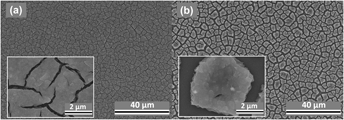Article contents
Dense and crack-free mullite films obtained from a hybrid sol–gel/dip-coating approach
Published online by Cambridge University Press: 18 April 2017
Abstract

A novel hybrid processing has been developed to achieve dense and crack-free mullite films with large critical thicknesses. The amorphous solid nanoparticles obtained from the mullite sol–gel precursor were mixed with the same liquid precursor to form stable suspensions, which were subsequently used to form mullite coatings with the dip-coating method, followed by drying and firing. The hybrid precursor suspensions resulted in highly close-packed nanoparticles, which reduced shrinkage during sintering. Selecting the solvent with a low evaporation rate and high surface tension can effectively eliminate the surface instability caused by the lateral flow during solvent evaporation. The mullite film density was significantly improved at low sintering temperatures, because of the high packing density and viscous flow at above the glass transition temperature of the amorphous gel nanoparticles before crystallization. Dense and crack-free mullite films with 500–600 nm thickness can be obtained from the novel hybrid approach.
- Type
- Articles
- Information
- Copyright
- Copyright © Materials Research Society 2017
Footnotes
Contributing Editor: Sam Zhang
References
REFERENCES
- 9
- Cited by





